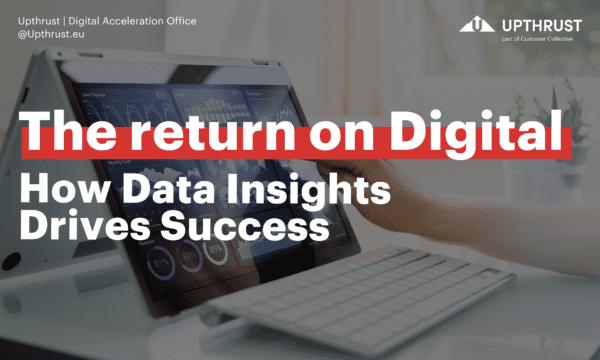Return on Digital: How Data Insights Drives Success

In today’s digital age, building a digital product that just looks beautiful or impressive is not enough. To achieve sustainable growth, any digital initiative must have a significant return on investment. This means that it must have a tangible impact on the customer’s goals, such as generating new revenue streams or reaching new audiences.
In this post, we’ll explore the aspects of digital projects and how they can be used to achieve sustainable growth for your organization.
Data as the Building Blocks
Data is crucial to growth marketing and digital products. Without data, it’s impossible to measure the impact of any digital project. At Upthrust Studio, we continuously gather and analyze data throughout the entire lifecycle of a product to ensure that it contributes to our customers’ goals. This is the key to having an accurate return on digital products and continuously optimizing them.
As Johan Steppe, Head of Digital Product Studio at Upthrust says, “Data is the lifeblood of digital products. It allows us to make informed decisions, optimize the product for better user experience, and drive adoption.”
Introductory Snooping and Scooping
Before building a digital product, conducting an initial research phase supported by data is crucial. This phase helps to identify the target audience, and understand their needs, preferences, and behaviors.
“Market research is essential to any successful digital product. It helps us to understand the customer’s mindset and design products that meet their needs.”
Building on this even further, conducting surveys, interviews, and organizing focus groups provide even clearer goals and objectives to work towards. Our Head of Digital Product Studio at Upthrust emphasizes that “User feedback is key to the success of any digital product. We listen to our users and incorporate their feedback into the product development process.”
Knock knock, … Upthrust here!
Progress during the process
Creating a growth marketing strategy can seem like a daunting task, but this is crucial in optimizing your
During the building process, data is a critical component of any digital product as it provides valuable insights into user behavior and preferences, which can help inform design decisions and optimize the user experience.
One approach to incorporating data into the building process is through the use of a minimum viable product (MVP). An MVP is a simplified version of a product that includes only the core features necessary to meet the needs of early adopters. By releasing an MVP to a small group of users and collecting feedback, developers can gather valuable data on user behavior, preferences, and pain points. This data can then be used to inform subsequent iterations of the product, ensuring that it continues to meet the evolving needs of users.
“By using MVPs, we can quickly validate our assumptions and iterate on the product based on user feedback. This allows us to deliver a product that meets the customer’s needs and expectations.”
After an MVP has been released and iterated upon, it’s essential to continue testing and gathering data to ensure that the product remains relevant and effective. One way to do this is through a beta test. Beta testers provide feedback on their experiences with the product, identifying any bugs or issues and suggesting improvements.
“Continuous testing and gathering insights are critical to the success of any digital product. By using beta testing, we can validate the product’s functionality and identify any areas that need improvement.”
There’s Never Enough
Even after launching, it’s essential to keep on gathering data on your product as it provides valuable insights into how users are interacting with it. By analyzing data, product teams can identify areas of improvement and make data-driven decisions to optimize the product for better user experience.
One powerful tool for gathering data is A/B testing. A/B testing involves randomly dividing users into two groups and presenting each group with a slightly different version of the product. By comparing the behavior and feedback of the two groups, product teams can determine which version performs better and should be implemented.
Additionally, a digital product studio like Upthrust can help organizations avoid the product abyss by providing expert guidance on the most effective features to prioritize based on data insights. Upthrust’s team of experienced developers, designers, and product managers work together to build and optimize digital products that meet their clients’ goals and provide tangible returns.
In conclusion, data insights play a critical role in the success of digital products. By incorporating data into every phase of the product development lifecycle, organizations can ensure that their products meet their customers’ goals, are optimized for user experience, and provide tangible returns.
At Upthrust, we understand the importance of data insights, and our digital product studio can help organizations build and optimize digital products that deliver results. Contact us today to learn more about how we can help your organization succeed in the digital age!
